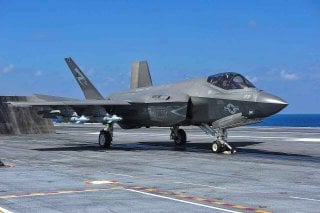Lockheed Martin Hit Its F-35 Delivery Target in 2024
Twenty-two F-35s were delivered in the final month of the year, and total deliveries exceeded 1,100—which remains the highest of any fifth-generation aircraft to date.
Lockheed Martin announced on Wednesday that it reached its high-end delivery goal for last year. In 2024, the aerospace and defense giant delivered 110 F-35 Lightning II stealth fighters to the United States military and partners. Twenty-two F-35s were delivered in the final month of the year, and total deliveries exceeded 1,100—which remains the highest of any fifth-generation aircraft to date.
Last summer, company CEO Jim Taiclet set a goal of 75 to 110 aircraft deliveries for 2024; and despite a year-long pause, which only ended in July, Lockheed Martin was able to reach its high-end goal. However, it did fall short of the planned objectives to deliver 156 jets annually beginning with calendar year 2024.
At issue was the aforementioned pause due to the delays with the F-35's Technology Refresh-3 (TR-3), a software and hardware update that is meant to significantly enhance the Lightning II's digital infrastructure and weapon systems. More than a software patch, TR-3 was meant to support the Block 4 capabilities of the aircraft.
As noted by the F-35 Joint Program Office (JPO), the TR-3's upgrade supports "new sensor suites, more long-range precision weapons, improved electronic warfare features, more powerful data fusion, and increased cross-platform interoperability. These capabilities provide the warfighter a combat-edge to identify, track, engage, and survive against advanced air, ground, and cyber threats. TR-3 significantly updates core processing power and memory capacity, which will allow the F-35 to run advanced software packed with state-of-the-art warfighting capabilities."
While the update was delayed until a truncated version was introduced last spring, more than 100 F-35s were completed and stored at Lockheed Martin's facilities in Fort Worth, Texas. Though deliveries did resume, and the Pentagon began to accept F-35 deliveries, those aircraft are only viable for training purposes.
The Department of Defense (DoD) has withheld around $5 million for each Lightning II until the TR-3 completes the upgrades.
As Aviation Week reported, "Software for combat-coded jets still lacks certification. The JPO expects Lockheed to clear the TR-3 software for operational missions later this year."
The U.S. Military's Joint Strike Fighter
The F-35—which is produced in three unique variants—is currently in service with the United States Air Force, the United States Navy, and the United States Marine Corps. According to data from the Government Accountability Office (GAO), combined the services operate around 650 of the all-weather multirole aircraft and have committed to acquiring around 1,800 additional Lightning IIs.
2024 ended with the U.S. Navy awarding a $11.76 billion contract modification for 145 aircraft. It is connected to a 2022 contract valued at $13.2 billion, which is already 51% completed. It is unlikely to change the number of aircraft slated for the fiscal year 2025 (FY25), however. In FY25, the U.S. Air Force is set to receive 48 F-35A fighters – the conventional takeoff and landing (CTOL) variant; while the U.S. Navy is expected to add fourteen F-35C, the carrier-based models, to its fleet. The United States Marine Corps will receive 15 F-35B models, the short takeoff and vertical landing (STOVL) variants, along with six F-35C aircraft.
"The government plans to pay for the jets by sourcing Air Force and Navy funds $2.5 billion and $2 billion, respectively from their annual aircraft procurement budgets for fiscal year 2024," the Fort Worth Report explained.
In addition to the F-35s slated for the U.S. military, 15 F-35As and one F-35B are also set to be delivered to U.S. defense partners—cost around $816.3 million. Moreover, 39 F-35As and seven F-35Bs are on track to be delivered as part of the foreign military sales (FMS) program.
Supporters of the program have questioned its future, as tech entrepreneur Elon Musk, a close ally of President-elect Donald Trump, has been increasingly critical of the F-35—arguing that drones should be adopted instead of a manned stealth fighter. However, the Lightning II has been adopted by 20 nations around the world, so perhaps the world's richest man isn't the smartest—at least on this issue.
Author Experience and Expertise: Peter Suciu
Peter Suciu is a Michigan-based writer. He has contributed to more than four dozen magazines, newspapers, and websites with over 3,200 published pieces over a twenty-year career in journalism. He regularly writes about military hardware, firearms history, cybersecurity, politics, and international affairs. Peter is also a Contributing Writer for Forbes and Clearance Jobs. You can follow him on Twitter: @PeterSuciu. You can email the author: [email protected].
Image Credit: Creative Commons and/or Shutterstock.

